Leafhopper: 5 tips for controlling and managing this pest
By Fabrício Pacheco, Product Manager at Adama
Due to their diversity and high destructive potential, lepidopterans are among the main pests in cotton. apple caterpillar, Helicoverpa armigera, false measure, the complex spodoptera and leafworm are some of these insects. To combat this, in addition to chemical control, it is necessary to comply with integrated management practices such as monitoring, maintenance and preservation of natural enemies, seed treatment and establishment of a specific sowing period for cultivation in each region.
In recent harvests, the occurrence of caterpillars has worried cotton growers, mainly species from the subfamily Heliothinae, such as the well-known apple caterpillar, Heliothis virescens, Ea Helicoverpa armigera, recently introduced in Brazilian conditions, in addition to the complex spodoptera, false caterpillar, Chrysodeixis includens (Walker) and the cotton leafworm, Alabama argillacea (Hübner).
The cotton leafworm, Alabama argillaceous, is the main defoliating pest. It can cause severe defoliation, as each caterpillar is capable of consuming 90cm² of leaf area to complete its cycle. With each harvest the attacks of this pest are occurring earlier, due to the remaining cotton plants (ratoon and tigueras) from the previous harvest, which remain among the soybean and corn crops and along the roads, feeding them and favoring reproduction. continuation of the plague.
The caterpillars are dark green in color, with two longitudinal striations on the back and have black spots all over the body. In high infestation, the caterpillars turn dark in color, giving the cotton grower an indication of the degree of infestation.

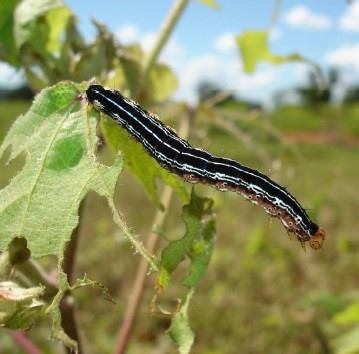
The damage initially occurs on young leaves of the pointer, which appear scraped and then on the median leaves of the plants, which show irregular perforations. Subsequently, widespread defoliation occurs, which can even attack the bracts of the reproductive structures. When the attack occurs in the opening of the apples, it causes their forced maturation, reducing the resistance of the fibers, and the feces can stain the fibers, depreciating them.
Control must be carried out when it reaches the level of 50% of plants with small caterpillars (less than 1,5 cm) or 30% of plants with large caterpillars (greater than 1,5 m), and the level of 25% may also be considered. of defoliation.

The apple caterpillar, Heliothis virescens, is a species with great potential to cause damage to cotton crops, capable of causing losses ranging from 18% to 32%, depending on the region. On average, for every 5% of infestation, 25% of apples will be destroyed. The eggs are deposited on the tips of the plants and the young caterpillars feed on the young leaves. After passing into the second instar, they move downwards, destroying flower buds from the pointer. When more developed, they attack larger flower buds, flowers and apples, destroying them. During the caterpillar phase, which lasts approximately 15 days, each individual can attack an average of seven reproductive structures. Outbreaks at the beginning of the harvest tend to be linked to the occurrence of high infestation in the previous crop, such as soybeans.
Sampling for apple caterpillars must be done throughout the plant, starting from the tips and the damage level is 6% to 8% of attacked plants. However, the presence of large caterpillars makes pest control difficult.
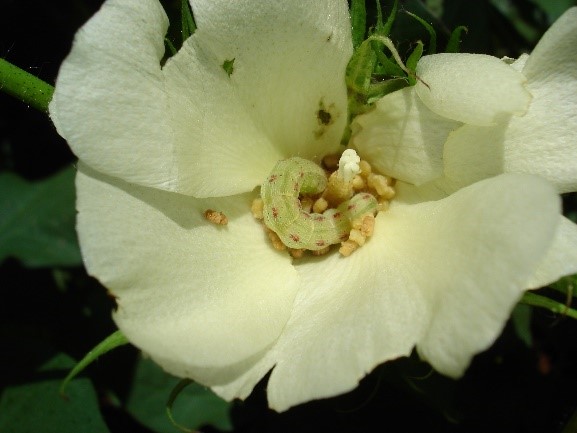
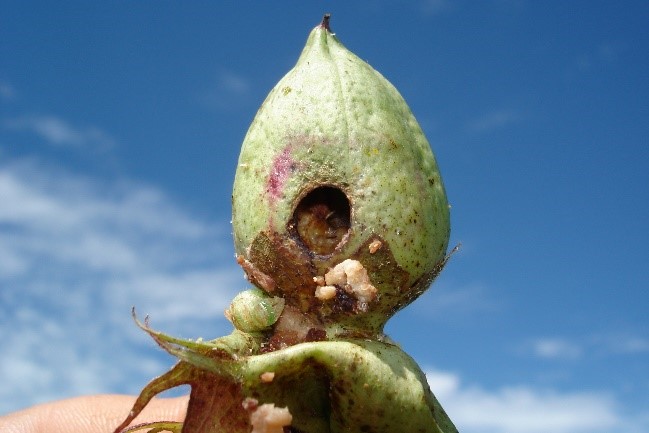
Caterpillars of the species H. armigera has high reproductive potential. Each female can oviposit up to 1.500 eggs, always placed singly on stems, flowers, fruits and leaves. The larval period consists of 5 to 6 instars and can last 2 to 3 weeks, depending on climatic conditions, during which time it causes damage. The species can feed on leaves and stems, however, it prefers buds, inflorescences, fruits and pods and causes damage in both the vegetative and reproductive phases, a behavior similar to that of the apple caterpillar. Both have high destructive potential, since the preference is for reproductive structures, directly affecting productivity.
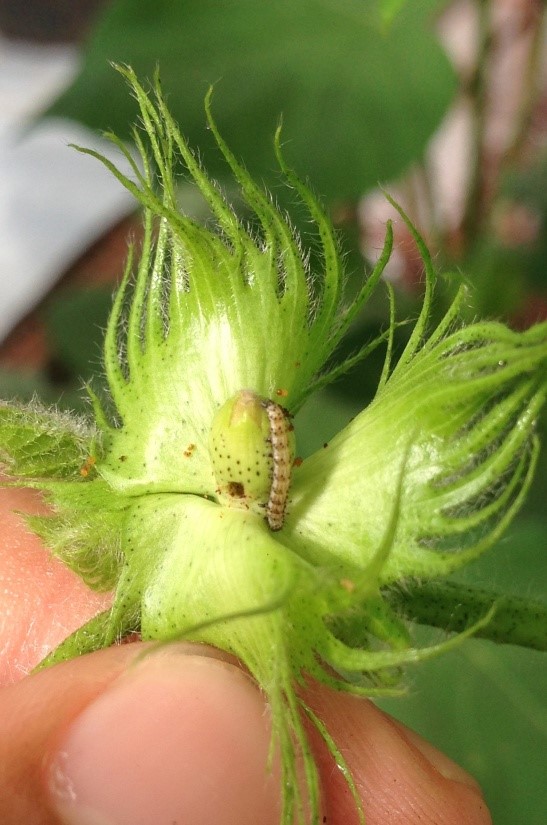
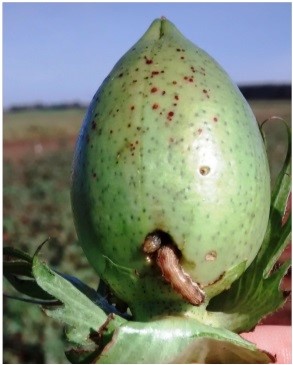
The Brazilian Association of Cotton Producers (Abrapa) estimates that losses in the 2012/2013 harvest in Brazil reached 2 billion reais, with emphasis on Bahia where losses of up to 80% were found in cotton production.
Studies carried out by Professor Geraldo Papa's research team demonstrated that each caterpillar (in a life cycle) can consume an average of 9,7 reproductive structures and the occurrence of 1 caterpillar/cotton plants has the power to reduce productivity by 14,1 %.
One of the alternatives that suit the integrated management of H. armigera is the use of insecticides of biological origin, such as HzNPV (Helicoverpazea Nucleopolyhedrovirus), which despite its specificity, is selective to natural enemies, has a good toxicological profile and has proven to be efficient in controlling the pest, as shown by the analysis developed by Professor Geraldo Papa's research team.

Caterpillars of the genus spodoptera that attack the cotton plant (Spodoptera frugiperda, Spodoptera cosmiodes e Spodoptera eridanea) are pests whose economic importance has grown year after year in cotton cultivation, mainly in agricultural areas of the Brazilian cerrado, causing severe damage that can significantly reduce fiber production. The causes of the population increase of the species in culture involve the intensive cultivation of the soil practiced in these areas, with a succession of host cycles throughout the year, favorable climatic conditions (high temperature and low relative humidity), the excessive and inappropriate use of insecticides with a broad spectrum of action, and, mainly, the planting of grasses such as corn, sorghum and millet in succession to the cotton crop. The insect's polyphagy and migratory capacity ensure its survival in unfavorable times, as the phenomenon of diapause does not occur in this species.
Another important fact is that the caterpillars that survive in the planting area after desiccation, exhibit screwworm behavior, remaining sheltered under clods and cultural debris during the day and at night, they come out to attack newly emerged plants, cutting them close. to the ground or destroying the leaves.


Caterpillars occur practically throughout the vegetative period of cotton crops, attacking all parts of the plant. The moths generally lay eggs in the middle part of the plants, where they oviposit an average of 100 grouped eggs, arranged in layers.
In recent harvests, the occurrence of Spodoptera eridania e cosmioides spodoptera in cotton crops, mainly in savannah regions, causing defoliation and damaging the fruiting organs. For Spodoptera, in addition to the percentage of plants attacked by the presence of caterpillars, it is important to quantify the intensity of the attack in terms of number of caterpillars per plant during sampling and consider this information to assist in decision making. Each caterpillar destroys an average of six productive structures, including two to three flower buds and three to four apples, during the larval cycle period. When apple caterpillar and military armyworm occur separately or in different periods, the same reference values are considered for their control. Control measures must be adopted when the level of 10% of plants or reproductive structures attacked is reached. However, the damage caused to cotton differs depending on the species.
With the aim of quantifying the differences between the caterpillars of Spodoptera frugiperda e Heliothis virescens As for the damage caused to the cotton plant, Professor Geraldo Papa and his team set up an experiment where cotton plants were infested with S. frugiperda and others with H. virescens and left to feed on the plants until pupating. The parameters evaluated were: number of reproductive structures damaged individually per species, productivity of plumes + seeds and observations of the behavior of caterpillars on plants. It was concluded that:
- Caterpillars H. virescens damaged a greater number of reproductive structures (average of 19.5 structures/plant) than caterpillars S. frugiperda (average of 5.6 structures/plant).
- The production of plants infested with S. frugiperda was 15.6% higher than the production obtained by plants infested with H. virescens.
- The caterpillars of S. frugiperda they moved less in the plants and consumed a large part of the attacked structures, consequently, the consumption of the number of structures was lower.
- Caterpillars H. virescens They moved a lot and consumed a small part of the attacked structures, but the number of damaged structures was greater.


Although transgenic cultivars express proteins that are toxic to most lepidopteran pests, the genus Spodoptera has been the major problem for these cultivars due to the caterpillars' lower sensitivity to Bt and VIP proteins. Thus, producers who adopt the technology and opt for transgenic cultivars (Bt) in the expectation of controlling all caterpillars end up needing to spray cotton crops to control Spodoptera, increasing their cost, as in addition to the greater value of transgenic seeds, the Lower-cost insecticides have not been effective in controlling Spodoptera, making it necessary to use more modern and more expensive insecticides. Therefore, for producing regions where the occurrence of Spodoptera is greater, the producer needs to be aware of the presence of the caterpillars, carrying out constant monitoring of the cotton fields to carry out chemical control when the caterpillars are still in their first instars.
The false measure (Chrysodeixis includens) is predominant in crops when compared to other species of Plusiinae. The discovery of high populations of false medadeira has worried producers and technicians in several producing regions, going from status from secondary pest to status of key pests in soybean crops and increased attack frequency in cotton.
The adults are moths with a wingspan of around 35 mm with dark gray upper wings, with a small silver design in the center, in the shape of a “U”, the eggs are laid singly on the underside of the leaves and on the tips, presenting a white color.
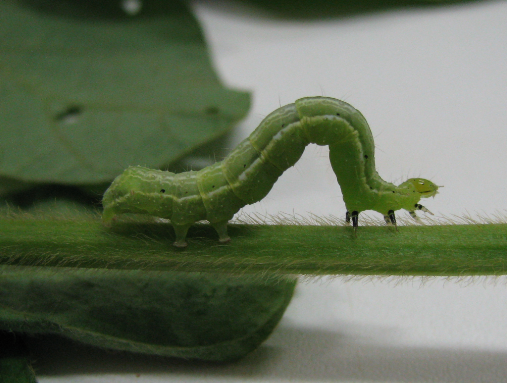

The damage caused by false leafminer is the defoliation caused by caterpillar feeding. The attack starts from the bottom with an upward direction. Leaf damage is circular perforations between the veins. The presence of 20% of plants with small caterpillars determines the time of control. The attack position of the caterpillars of this species, below the lower half of the plants, makes the control action of insecticides difficult, as in conventional applications the amount of substance that reaches the lower strata of the plants is relatively small. Late defoliation during the boll opening period is caused by mixed populations of leafworm and leafworm and control must be carried out before the deposition of excrement on the fibers. The attack on cotton crops coincides with the maturation of soybean crops.
Caterpillar management is complex. It must be implemented at a regional level, since most species have a polyphagous habit. The main form of controlling these pests is chemical control, largely due to the practicality of the method, associated with the rapid achievement of desirable results and frequent economic viability. However, in most cases collective management measures are not implemented, favoring the reproduction and dispersion of pests and, in these conditions, insecticides do not provide the expected effectiveness, that is, insecticides become the only measure to combat pests. pests and “succumb to so much responsibility”.
Therefore, it is extremely necessary for modern cotton farming to interact with the practices proposed by Integrated Pest Management (IPM), such as monitoring, control levels, use of pheromones, maintenance and preservation of natural enemies, insect resistance management , seed treatment, pest control during desiccation prior to sowing, sanitary void, efficient control of ratoons and volunteer plants, pest control in end-of-cycle crops and those that would “supply” pests for the following crop and establishment of a specific period sowing date (“window”) for cultivation in each region.


Geraldo Papa, João Antonio Zanardi Jr., Roberto da Silva and Fernando Juari Celoto, Unesp - Ilha Solteira Campus/SP
Article published in issue 203 of Cultivar Grandes Culturas.

Receive the latest agriculture news by email